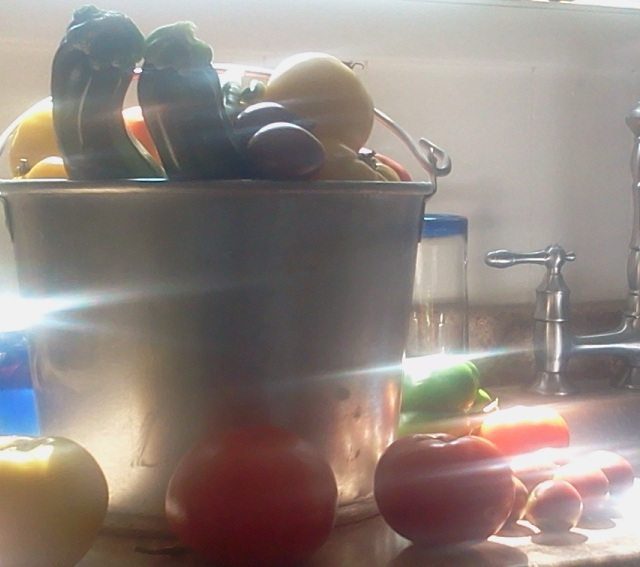 Got a crappy camera on your smartphone? It might not be as useless as you think it is. This discovery makes up for a lot of the inferior photos mine takes… catching invisible bands of sunlight on film. Notice how the shadow of the one tomato in the foreground is broken as the band is falling in front of it? Pretty crazy. Totally cool!
Got a crappy camera on your smartphone? It might not be as useless as you think it is. This discovery makes up for a lot of the inferior photos mine takes… catching invisible bands of sunlight on film. Notice how the shadow of the one tomato in the foreground is broken as the band is falling in front of it? Pretty crazy. Totally cool!
I almost deleted this whole series of photos before I saw them on a big screen, and so happy it would have been too tedious to leave them out when transferring a large amount of images from phone to computer. The goal was to get one half-way decent shot of the day’s garden harvest to text to a friend. They all seemed a total loss, nothing but way too much white afternoon sunshine blasting through the window, but in the end clearly show sunlight falling in bands.
So, today I set out on a mission to decipher what is going on in the photos. I came up empty handed, but maybe some of those awesome grow light folks in the industry can explain them more scientifically without err in comments. The only clever things I can offer are some really cool pics and the realization that bands of sun energy aren’t always curved. Here I’ve discovered that they not only fall evenly spaced, but also in a grid.
This window faces due south. The photo below with vertical bands of light falling across the vegetables were taken while the camera was pointing southeast, and horizontal bands appeared when facing SW to SSW. I was trying to get rid of as much of the sun’s glare as possible. At first, I didn’t realize that the bands were there, I was unhappy about all the color being washed out of the lovely veggies that I could see that the sun robbed the camera’s lens from displaying. Then I noticed that these streaks of light were perfectly straight, and at the same intervals apart, as if someone had drawn them with a ruler.

And it wasn’t until I started writing this post that I saw that there were two different angles to the bands – depending on which direction the camera’s eye was pointed. It’s not just glare. They are too regularly spaced for that, and the broken shadow in the first image is total proof of that. Here’s another frame…

In the above image, my first thought on upon noticing the dark mottling on the two large tomatoes in the shadows in front of the bucket was just the inferior camera was making everything grainy, yet the only other part of the photo that has this kind of pattern is the counter top. And the closer you study the photo, you begin wondering if it isn’t somehow reflecting the pattern of the counter itself, because that’s exactly what it looks like. It could be a visual illusion. Hard to tell with this camera, but definitely worth considering, because the heat from the sun couldn’t possibly have disintegrated in the few moments that elapsed between covering the counter with just picked veggies and snapping these pics.

So… waves of energy from the sun falls on a grid? Is it because the thermal pane window glass is distorting them? Maybe the screen on the window has something to do with it. I don’t know, and couldn’t find an answer after a couple hours of searching. Even if no expert comes forward to explain the technicalities involved, these pics are very cool despite them not being HD quality images.
This particular cheap Samsung Droid also picks up the flicker on the monitor screen that isn’t seen with the eye, and the flicker that fluorescent lights give off too. From what I read today, any low-quality digital camera picks up infrared waves, but these aren’t waves – they are bands. I don’t think the flicker on your monitor or under a T5 grow light is infrared either.
A new reason to run out and buy a burner phone… to capture the sun’s energy in a totally new light.